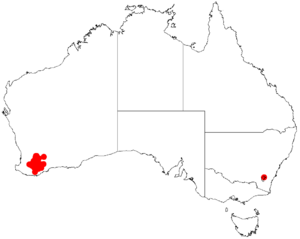Acacia pulviniformis facts for kids
Quick facts for kids Acacia pulviniformis |
|
|---|---|
| Scientific classification | |
| Genus: |
Acacia
|
| Species: |
pulviniformis
|
 |
|
| Occurrence data from AVH | |
Acacia pulviniformis is a special type of Acacia bush, also known as a Wattle tree. It's a small, spiky shrub that grows low to the ground. You can only find this plant in the southwestern part of Australia. It's a unique part of the Australian landscape!
What Does It Look Like?
This spiky, low-growing bush is usually between 0.05 to 0.25 metres (0.2 to 0.8 ft) tall. It often forms thick, tangled mats on the ground. Its small branches are spiny and straight.
The leaves, called phyllodes, are smooth and green. They are usually straight or slightly curved, about 4 to 11 mm (0.16 to 0.43 in) long and 0.4 to 0.7 mm (0.016 to 0.028 in) wide. They have a faint line down the middle.
Acacia pulviniformis blooms from August to October. It produces small, round, golden-yellow flowers. Each flower head is about 2 to 2.5 mm (0.079 to 0.098 in) across and contains six to seven tiny flowers.
After the flowers, the plant grows seed pods. These pods are tightly coiled and about 1 cm (0.39 in) long and 2.5 mm (0.098 in) wide. Inside, the seeds are dark brown and slightly shiny. They are about 2.5 mm (0.098 in) long and shaped like wide ovals.
How Was It Named?
This plant was first officially described in 1928. Two botanists, Joseph Maiden and William Blakely, gave it its scientific name. They wrote about it in a paper that described many new types of Acacia plants from Western and Northern Australia.
Later, in 2003, another botanist named Leslie Pedley changed its name to Racosperma pulviniforme. However, in 2006, it was moved back to the Acacia group. Sometimes, people confuse this plant with another similar species called Acacia oxyclada.
Where Does It Grow?
Acacia pulviniformis is found in the Wheatbelt and Great Southern areas of Western Australia. You can see it from places like Corrigin in the north down to Mount Barker in the south.
It likes to grow in damp, low-lying spots. It can be found in sandy, clay, or loamy soils, often with rocky gravel called lateritic gravel. This plant usually grows in open forests where Eucalyptus wandoo trees are common. It can also be found in areas that have been disturbed, like by human activity.

